Ceres
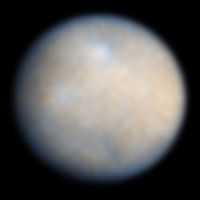
Ceres appears to be a rocky-object and an astronomical object.
Astronomy
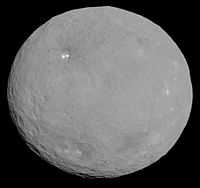
The image on the right was taken by NASA's Dawn spacecraft on May 5 and 6, 2015, from a distance of 8,400 miles (13,600 kilometers).
Planetary sciences
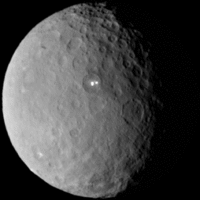
The Gamma Ray and Neutron Detector (GRaND) onboard the Dawn spacecraft "is based on similar instruments flown on the Lunar Prospector and Mars Odyssey space missions. It will be used to measure the abundances of the major rock-forming elements (oxygen, magnesium, aluminium, silicon, calcium, titanium, and iron) on Vesta and Ceres, as well as potassium, thorium, uranium, and water (inferred from hydrogen content).[1][2][3][4][5][6]"[7]
"Ceres rotates in this sped-up movie [on the right] comprised of images taken by NASA's Dawn mission during its approach to the dwarf planet. The images were taken on Feb. 19, 2015, from a distance of nearly 29,000 miles (46,000 kilometers). Dawn observed Ceres for a full rotation of the dwarf planet, which lasts about nine hours. The images have a resolution of 2.5 miles (4 kilometers) per pixel."[8]
Theoretical Ceres astronomy
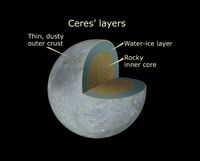
Def. "a celestial body that
(a) is in orbit around the Sun,
(b) has sufficient mass for its self-gravity to overcome rigid forces so that it assumes a hydrostatic equilibrium (nearly round) shape,
(c) has not cleared the neighbourhood around its orbit, and
(d) is not a satellite" is called a dwarf planet.[9]
"Ceres ... is the smallest identified dwarf planet in the solar system".[10]
"Observations of 1 Ceres, the largest known asteroid, have revealed that the object may be a "mini planet," and may contain large amounts of pure water ice beneath its surface."[11]
"The observations by NASA's Hubble Space Telescope also show that Ceres shares characteristics of the rocky, terrestrial planets like Earth. Ceres' shape is almost round like Earth's, suggesting that the asteroid may have a "differentiated interior," with a rocky inner core and a thin, dusty outer crust."[11]
"Ceres is an embryonic planet. Gravitational perturbations from Jupiter billions of years ago prevented Ceres from accreting more material to become a full-fledged planet."[12]
"Computer models [such as the image on the right] show that a nearly round object like Ceres has a differentiated interior, with denser material at the core and lighter minerals near the surface. All terrestrial planets have differentiated interiors. Asteroids much smaller than Ceres have not been found to have such interiors."[11]
"The astronomers suspect that water ice may be buried under the asteroid's crust because the density of Ceres is less than that of the Earth's crust, and because the surface bears spectral evidence of water-bearing minerals. They estimate that if Ceres were composed of 25 percent water, it may have more water than all the fresh water on Earth. Ceres' water, unlike Earth's, would be in the form of water ice and located in the mantle, which wraps around the asteroid's solid core."[11]
Planetary astronomy
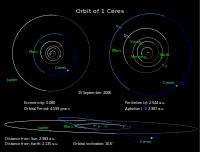
"The diagram illustrates the orbits of Ceres (blue) and several planets (white/grey). The segments of orbits below the ecliptic are plotted in darker colours, and the orange plus sign is the Sun's location. The top left diagram is a polar view that shows the location of Ceres in the gap between Mars and Jupiter. The top right is a close-up demonstrating the locations of the perihelia (q) and aphelia (Q) of Ceres and Mars. Interestingly, the perihelia of Ceres (as well as those of several other of the largest MBAs) and Mars are on the opposite sides of the Sun. The bottom diagram is a perspective view showing the inclination of the orbit of Ceres compared to the orbits of Mars and Jupiter."[13]
Asteroids
"Ceres ... is ... the only [dwarf planet] in the asteroid belt.[14]"[10]
"Ceres is approximately 580 miles (930 kilometers) across, about the size of Texas. It resides with tens of thousands of other asteroids in the main asteroid belt. Located between Mars and Jupiter, the asteroid belt probably represents primitive pieces of the solar system that never managed to accumulate into a genuine planet. Ceres comprises 25 percent of the asteroid belt's total mass. However, Pluto, our solar system's smallest planet, is 14 times more massive than Ceres."[11]
"The astronomers used Hubble's Advanced Camera for Surveys to study Ceres for nine hours, the time it takes the asteroid to complete a rotation. Hubble snapped 267 images of Ceres. From those snapshots, the astronomers determined that the asteroid has a nearly round body. The diameter at its equator is wider than at its poles."[11]
Recent history
The recent history period dates from around 1,000 b2k to present.
“When Ceres has an opposition near the perihelion, it can reach a visual magnitude of +6.7.[15] This is generally regarded as too dim to be seen with the naked eye, but under exceptional viewing conditions a very sharp-sighted person may be able to see this dwarf planet.”[10]
"Besides being the largest asteroid, Ceres also was the first asteroid to be discovered. Sicilian astronomer Father Giuseppe Piazzi spotted the object in 1801. Piazzi was looking for suspected planets in a large gap between the orbits of Mars and Jupiter. As more such objects were found in the same region, they became known as "asteroids" or "minor planets.""[11]
Research
Hypothesis:
- Ceres is another cratered surface, rocky object.
Control groups

The findings demonstrate a statistically systematic change from the status quo or the control group.
“In the design of experiments, treatments [or special properties or characteristics] are applied to [or observed in] experimental units in the treatment group(s).[16] In comparative experiments, members of the complementary group, the control group, receive either no treatment or a standard treatment.[17]"[18]
Proof of concept
Def. a “short and/or incomplete realization of a certain method or idea to demonstrate its feasibility"[19] is called a proof of concept.
Def. evidence that demonstrates that a concept is possible is called proof of concept.
The proof-of-concept structure consists of
- background,
- procedures,
- findings, and
- interpretation.[20]
See also
References
- ↑ "Science Payload". Retrieved 2010-03-21.
- ↑ "GRaND science instrument moves closer to launch from Cape". Retrieved 2010-03-21.
- ↑ Kevin Righter, Michael J. Drake (1997). "A magma ocean on Vesta: Core formation and petrogenesis of eucrites and diogenites". Meteoritics & Planetary Science 32 (6): 929–944. doi:10.1111/j.1945-5100.1997.tb01582.x.
- ↑ Michael J. Drake (2001). "The eucrite/Vesta story". Meteoritics & Planetary Science 36 (4): 501–13. doi:10.1111/j.1945-5100.2001.tb01892.x.
- ↑ Thomas H. Prettyman (2004). "Mapping the elemental composition of Ceres and Vesta: Dawn[quotation mark]s gamma ray and neutron detector". Proceedings of SPIE. 5660. pp. 107. doi:10.1117/12.578551.
- ↑ . doi:10.1109/TNS.2003.815156.
- ↑ "Dawn (spacecraft), In: Wikipedia". San Francisco, California: Wikimedia Foundation, Inc. May 3, 2013. Retrieved 2013-05-08.
- ↑ Tony Greicius (27 February 2015). "Ceres Awaits Dawn". Pasadena, California USA: NASA/JPL. Retrieved 2015-12-15.
- ↑ Lars Lindberg Christensen (August 24, 2006). "IAU 2006 General Assembly: Result of the IAU Resolution votes". International Astronomical Union. Retrieved 2011-10-30.
- 1 2 3 "Ceres (dwarf planet), In: Wikipedia". San Francisco, California: Wikimedia Foundation, Inc. March 21, 2012. Retrieved 2012-03-21.
- 1 2 3 4 5 6 7 Dolores Beasley, Susan Hendrix, and Donna Weaver (7 September 2005). "Largest Asteroid May Be 'Mini Planet' with Water Ice". Baltimore, Maryland USA: Hubblesite. Retrieved 2015-12-15.
- ↑ Lucy A. McFadden (7 September 2005). "Largest Asteroid May Be 'Mini Planet' with Water Ice". Baltimore, Maryland USA: Hubblesite. Retrieved 2015-12-15.
- ↑ Orionist (6 November 2006). "File:Ceres Orbit.svg, In: Wikimedia Commons". San Francisco, California: Wikimedia Foundation, Inc. Retrieved 2015-12-15.
- ↑ "NASA – Dawn at a Glance". NASA. Archived from the original on 2011-10-05. Retrieved 14 August 2011.
- ↑ Menzel, Donald H.; and Pasachoff, Jay M. (1983). A Field Guide to the Stars and Planets (2nd ed.). Boston, MA: Houghton Mifflin. p. 391. ISBN 978-0-395-34835-2.
- ↑ Klaus Hinkelmann, Oscar Kempthorne (2008). Design and Analysis of Experiments, Volume I: Introduction to Experimental Design (2nd ed.). Wiley. ISBN 978-0-471-72756-9. http://books.google.com/?id=T3wWj2kVYZgC&printsec=frontcover.
- ↑ R. A. Bailey (2008). Design of comparative experiments. Cambridge University Press. ISBN 978-0-521-68357-9. http://www.cambridge.org/uk/catalogue/catalogue.asp?isbn=9780521683579.
- ↑ "Treatment and control groups, In: Wikipedia". San Francisco, California: Wikimedia Foundation, Inc. May 18, 2012. Retrieved 2012-05-31.
- ↑ "proof of concept, In: Wiktionary". San Francisco, California: Wikimedia Foundation, Inc. November 10, 2012. Retrieved 2013-01-13.
- ↑ Ginger Lehrman and Ian B Hogue, Sarah Palmer, Cheryl Jennings, Celsa A Spina, Ann Wiegand, Alan L Landay, Robert W Coombs, Douglas D Richman, John W Mellors, John M Coffin, Ronald J Bosch, David M Margolis (August 13, 2005). "Depletion of latent HIV-1 infection in vivo: a proof-of-concept study". Lancet 366 (9485): 549-55. doi:10.1016/S0140-6736(05)67098-5. http://www.ncbi.nlm.nih.gov/pmc/articles/PMC1894952/. Retrieved 2012-05-09.
External links
- African Journals Online
- Bing Advanced search
- Google Books
- Google scholar Advanced Scholar Search
- International Astronomical Union
- JSTOR
- Lycos search
- NASA/IPAC Extragalactic Database - NED
- NASA's National Space Science Data Center
- Office of Scientific & Technical Information
- Questia - The Online Library of Books and Journals
- SAGE journals online
- The SAO/NASA Astrophysics Data System
- Scirus for scientific information only advanced search
- SDSS Quick Look tool: SkyServer
- SIMBAD Astronomical Database
- SIMBAD Web interface, Harvard alternate
- Spacecraft Query at NASA.
- SpringerLink
- Taylor & Francis Online
- Universal coordinate converter
- Wiley Online Library Advanced Search
- Yahoo Advanced Web Search
![]() This is a research project at http://en.wikiversity.org
This is a research project at http://en.wikiversity.org
| |
Development status: this resource is experimental in nature. |
| |
Educational level: this is a research resource. |
| |
Resource type: this resource is an article. |
| |
Resource type: this resource contains a lecture or lecture notes. |
| |
Subject classification: this is an astronomy resource. |